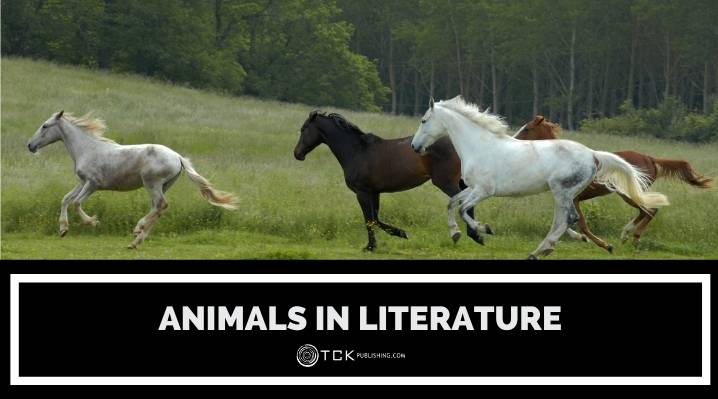
Many of us grew up surrounded by stories that featured memorable animals. They enriched the setting of the story, acted as faithful companions to the protagonist, or became the central characters themselves.
While most of these animals are now restricted to children’s fiction, there was a time when all stories featured them as characters. They went on adventures, learned the truths of the world, and imparted wisdom to their readers.
Famous Animals in Literature
Animals found in stories are a cherished part of our childhood, and on occasion, our adult lives. From the sinister Shere Khan to everyone’s favorite bear, Winnie-the-Pooh, here is a list of literature’s most memorable animals.
1. Aslan from C.S. Lewis’ The Chronicles of Narnia
The lion has long been used as a symbol of nobility, courage, and strength—all things that Aslan has in abundance. He represents the good in the world and never fails to be there whenever he is needed.
Throughout the series, he encourages and guides many of the characters into accepting themselves and achieving greatness. And because of his kindness, his subjects love him so fiercely that even after years of disappearing, he can still command their loyalty.
2. Shere Khan from Rudyard Kipling’s The Jungle Book
The book is full of memorable animals: Baloo the bear, Bagheera the panther, Rikki-Tikki-Tavi the mongoose, and so on. But Shere Khan beats them all in terms of sheer presence. He’s arrogant and powerful, with the majority of the jungle’s inhabitants afraid of him.
He spends much of the story scheming to have Mowgli as his dinner. He turns the wolves against each other, even succeeding in ousting their leader from the pack. And despite his lame leg, he proves himself a troublesome opponent for his enemies.
3. Hedwig from J.K. Rowling’s Harry Potter series
Hedwig is Harry’s pet snowy owl, who’s important to the story for several reasons. She’s the first proper birthday gift that Harry has ever received; she’s the only constant connection he has to the wizarding world; and in Harry’s own words, she’s “the only friend he had at number four, Privet Drive.”
In the end, she dies from a Death Eater attack, symbolizing Harry’s loss of innocence. Her death adds to Harry’s motivation to finally end the war with Voldemort.
4. Moby Dick from Herman Melville’s Moby Dick
In the novel, Moby Dick is an albino sperm whale that might just be the largest of its kind. It’s a force of nature fighting against the progress of humanity. It bites off Captain Ahab’s leg, serving as one of the most famous examples of man against nature.
The whale, a ruthless killer, is well known for its hostility against whaling ships. Its hatred is so intense that it instills dread in its victims and the readers themselves.
5. Mr. Fox from Roald Dahl’s Fantastic Mr. Fox
Mr. Fox lives underground with his wife and children. He’s also a thief, using his cleverness to outsmart three wicked farmers and seize their livestock so he can feed his family.
Most foxes are portrayed as malicious tricksters, but Mr. Fox comes off as more compassionate and helpful. While he can certainly ignore the other animals, he graciously invites them to a feast as an apology for them getting caught up in his feud with the farmers.
6. Buck from Jack London’s The Call of the Wild
The pampered Buck is stolen and sold into service as a sled dog. As the novel unfolds, we see him transform from a soft, inexperienced pet to a battle-hardened hound.
He learns how to survive in the frozen climate, fights his way into the lead dog position, and relearns how to trust humans when he meets John Thorton. In the end, he responds to the call of the wild, joining a feral pack and becoming a legend amongst the natives.
7. Napoleon from George Orwell’s Animal Farm
Napoleon is “a big fierce-looking boar, the only Berkshire pig on the farm and reputed to always get his way.” So it’s no surprise that he’s one of the leaders in a rebellion of animals against their cruel, human farmer.
Meant to symbolize Stalin, Napoleon eventually rules the farm as a dictator. He exiles a rival, sells a loyal citizen for booze, and ostracizes the many to cater to a select few. His greatest crime, however, is becoming the same authority figure he rebelled against in the first place.
8. Charlotte from E.B. White’s Charlotte’s Web
Charlotte A. Cavatica is a clever spider quietly living in a barn—until Wilbur the pig comes along. When Wilbur is in danger of being slaughtered, Charlotte decides to do something about it.
She becomes a steadfast friend to Wilbur, toiling away with her messages and asking nothing in return from Wilbur. And though the ending is bittersweet, readers are left with no doubt that she lived her life with a purpose.
9. Winnie-The-Pooh from A.A. Milne’s Winnie-The-Pooh
Who could forget this lovable, honey-obsessed bear? An anthropomorphic bear, Pooh is a thoughtful, sociable, and steadfast friend to the other animals living in the Hundred Acre Wood.
And while he and his friends agree on him being “a bear of very little brain,” he can be clever at times, often when one of his friends needs saving. He’s also a talented poet, with many of the stories featuring his poems and “hums.” All in all, a very well-rounded bear!
10. Black Beauty from Anna Sewell’s Black Beauty
Black Beauty is a majestic horse with one white foot and a pretty white star on his forehead. He starts his career as a carriage horse for the wealthy, serving them to the best of his abilities. But an unfortunate accident sees him being used for much harder work.
He goes through multiple owners, some cruel, some kind. Despite it all, he perseveres. While this horse’s fictional autobiography is considered a children’s novel nowadays, it was responsible for educating 19th-century society about better animal welfare.
11. Peter Cottontail from Beatrix Potter’s The Tale of Peter Rabbit
The titular character is a mischievous and disobedient rabbit famous for his blue jacket with brass buttons. He’s a bit greedy too, snacking on as much of Mr. McGregor’s vegetables as he can. In the end, he loses his precious clothes and is put to bed while his siblings enjoy a scrumptious dinner.
It’s a powerful story about the dangers of misbehaving. While Peter experiences a moment of pure bliss, it’s not worth the terror of being chased and the disappointment of his mother. Despite that, Peter goes on a few more misadventures in the next books.
12. Toad from Kenneth Grahame’s The Wind in the Willows
While there are four main animal characters in this book, Toad stands out as the most chaotic of them all. While he’s sociable and well-meaning, he’s also immature with a tendency to boast and make outrageous statements, which always lands him in trouble.
He’s also prone to obsessions that he often drops after a short while. In the books, he obsesses over punting, boats, and horse-drawn caravans before finally settling on motorcars. His brash behavior doesn’t mellow out, as his obsession turns into an outright addiction that his friends help him control.
13. The Cheshire Cat from Lewis Carroll’s Alice in Wonderland
The Cheshire Cat is one of the most popular animals in children’s fiction, and has since become enmeshed in popular culture. He’s iconic for always appearing and disappearing, leaving only one last image: its big, toothy grin.
Mischievous and mysterious, he frequently engages Alice and other characters in philosophical, but perplexing conversation. One of the best scenes in the book is when he is sentenced to death but baffles everyone by making his head appear without its body, sparking a debate whether a disembodied head can be beheaded.
14. Paddington Bear from Michael Bond’s A Bear Called Paddington
With his old hat, battered suitcase, and coat in hand, Paddington travels all the way from “Darkest Peru” to London. There, he is adopted by the Brown family, who introduces him to life in London.
While always full of good intentions, his cluelessness often lands him in trouble. He has the right spirit though, always persevering to get things right. He’s also a softie at heart, always polite and never passing the chance to introduce people to his favorite marmalade.
15. George from Margret and H.A. Rey’s Curious George series
George is an orphaned chimpanzee living in the jungles of Africa. The Man in the Yellow Hat, feeling sorry for him, decides to take him home to a zoo. Overly curious about his new surroundings, George gets into a lot of adventures before finally being taken to his new home.
George’s curiosity is a great representation of a child’s curiosity. While his curiosity does get him into trouble, it makes life more interesting and presents opportunities to learn more about the awesome world around him.
Animals and Stories
In the beginning, almost all stories had animals as their main characters. They were the heroes and villains, the winners and losers, and the good and evil. Perhaps it was because people were closer to nature back then, living lives that were more connected to animals compared to how we live today.
In fact, it was common for gods to have animal aspects (eagle for Zeus, elephant for Ganesh, crow for the Morrigan, and more). Myths and folk tales are full of such examples. But perhaps the original stories featuring animals as characters are fables, the most famous being Aesop’s.
The animals in these stories are often anthropomorphized to make them more relatable to people. What is alien is made familiar while simultaneously exploring the difference between animals and humans.
For example, some animals are shown wearing clothes and walking on their hind legs, but still follow their species’ eating habits and living conditions.
Animal characters are also used in ways that human characters are not. Readers demand less reality from animals, while human characters, despite being fictional, are still judged by how realistic they feel.
This is because an animal is relatively unknowable. Unless science can identify how they think and feel, their inner selves will always be a mystery. Readers take that into consideration when viewing them as characters, so an animal can get away with being a shallow villain, while a human must demonstrate why they are evil.
Do you have a favorite animal from literature? Share them with us in the comments below!
If you enjoyed this post, then you might also like:
- 12 Books About Animals That Will Bring You Closer to Nature
- 100 Literary Dog Names: Fun Ideas for Bookworms and Their Best Friends
- Parable vs. Fable: What’s the Difference?

Cole is a blog writer and aspiring novelist. He has a degree in Communications and is an advocate of media and information literacy and responsible media practices. Aside from his interest in technology, crafts, and food, he’s also your typical science fiction and fantasy junkie, spending most of his free time reading through an ever-growing to-be-read list. It’s either that or procrastinating over actually writing his book. Wish him luck!
